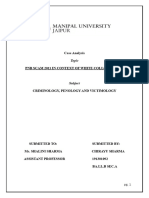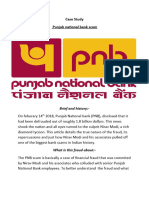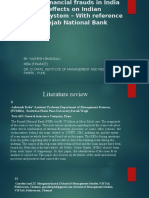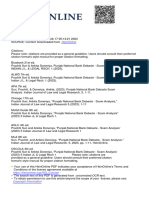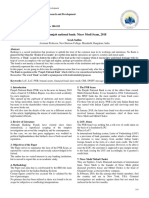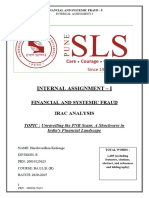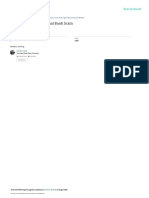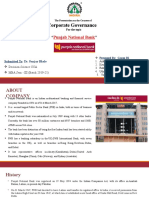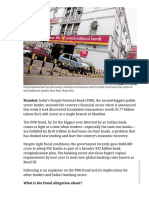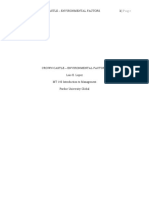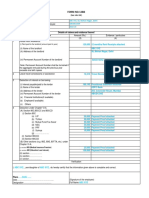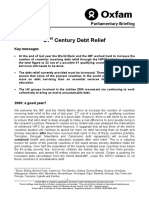The Punjab National Bank (PNB) Scam: A Detailed Analysis
Introduction
The Punjab National Bank (PNB) scam is one of the largest banking frauds in
India’s history, involving fraudulent transactions worth approximately ₹11,400
crores (around $1.8 billion). The scam, which surfaced in early 2018, exposed
severe lapses in India’s banking system and raised concerns about regulatory
oversight, financial governance, and corporate ethics. The primary accused,
billionaire jeweler Nirav Modi and his uncle Mehul Choksi, allegedly used
unauthorized Letters of Undertaking (LoUs) issued by PNB to obtain credit from
overseas banks.
This essay provides an in-depth analysis of the PNB scam, covering its
background, key players, modus operandi, legal proceedings, impact on
stakeholders, and the lessons learned for the future of India’s financial sector.
Background of Punjab National Bank
Punjab National Bank (PNB) is one of India’s oldest and largest public sector
banks, established in 1894. With a vast network of branches across the country
and international presence, PNB has been a key player in India’s banking sector.
Despite its strong reputation, the bank fell victim to one of the biggest financial
frauds, revealing major vulnerabilities in its internal controls and risk
management processes.
The Key Players
1. Nirav Modi - A billionaire jeweler and businessman, founder of Firestar
Diamond International, who is accused of orchestrating the scam.
2. Mehul Choksi - Owner of Gitanjali Gems and Nirav Modi’s uncle, also a
key conspirator in the fraud.
3. PNB Officials - Several bank officials, including senior employees, were
allegedly complicit in the scam by allowing unauthorized transactions.
4. Foreign Banks - A few foreign banks, including Allahabad Bank and Axis
Bank, were also involved in providing credit based on fraudulent LoUs.
5. Enforcement Directorate (ED) & Central Bureau of Investigation
(CBI) - Indian agencies investigating the scam and initiating legal
proceedings.
Modus Operandi of the Scam
The scam was orchestrated using fraudulent Letters of Undertaking (LoUs).
LoUs are bank guarantees that allow a bank’s customer to obtain credit from
another bank’s foreign branch. Here’s how the scam unfolded:
1. Issuance of Unauthorized LoUs: PNB officials issued LoUs without
proper authorization or collateral, allowing Nirav Modi’s firms to borrow
money from overseas banks.
2. SWIFT Manipulation: The transactions were not recorded in PNB’s Core
Banking System (CBS), preventing detection.
� 3. Rolling Credit: The scam continued for years as the borrowed amounts
were used to repay previous loans, creating an illusion of regular
repayments.
4. Detection and Exposure: The fraud was exposed when PNB refused to
honor fresh LoUs, leading to an investigation and subsequent legal action.
Legal Proceedings and Current Status
After the scam was uncovered, Indian authorities launched a nationwide
investigation, leading to multiple arrests and legal battles.
1. Nirav Modi was arrested in the UK in 2019 and faces extradition to India.
2. Mehul Choksi fled to Antigua and obtained citizenship, leading to
international legal proceedings for his extradition.
3. PNB Officials involved in issuing fraudulent LoUs were arrested and faced
legal action.
4. Enforcement Directorate (ED) seized assets worth thousands of crores
belonging to Nirav Modi and Mehul Choksi.
5. Legal Reforms: The Indian government introduced stricter regulations to
prevent such frauds in the future.
Impact of the Scam
The scam had far-reaching consequences for multiple stakeholders:
Punjab National Bank: The bank suffered huge financial losses and a
decline in its stock value.
Indian Banking Sector: The incident highlighted serious gaps in the
financial regulatory system.
Government and Regulatory Bodies: Led to stricter banking policies
and oversight measures.
Foreign Investors: Eroded confidence in India’s banking sector,
impacting investments.
Public and Depositors: Increased concerns over security and
transparency in banking operations.
Preventive Measures and Reforms
1. Strengthening Internal Controls: Banks must implement stronger
checks on LoUs and other financial instruments.
2. Enhancing Digital Surveillance: Using advanced technology like AI and
blockchain for fraud detection.
3. Regular Audits: Ensuring periodic internal and external audits to identify
discrepancies.
4. Accountability Measures: Holding bank officials accountable for lapses
in oversight.
� 5. Public Awareness: Educating customers about banking frauds and
security measures.
Conclusion
The PNB scam serves as a stark reminder of the vulnerabilities in India’s banking
system and the urgent need for regulatory reforms. While legal proceedings
continue, the case has already led to significant policy changes aimed at
improving financial transparency and corporate governance. Moving forward, it is
essential to implement robust mechanisms to prevent such frauds and restore
trust in the country’s banking institutions.
The scam also underscores the importance of vigilance, ethical business
practices, and the role of technology in fraud prevention. As India’s economy
continues to grow, ensuring the integrity of its financial systems remains a top
priority.





















